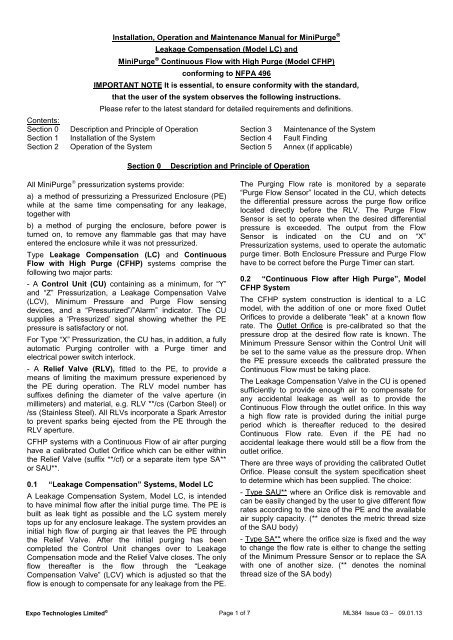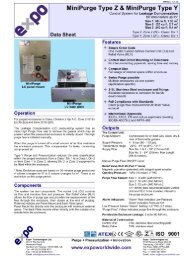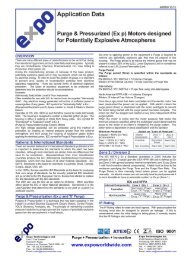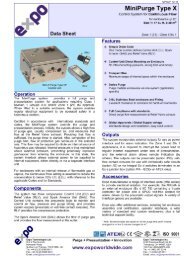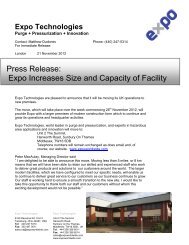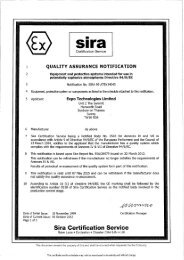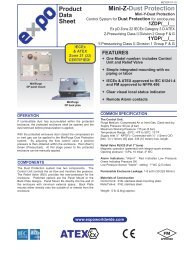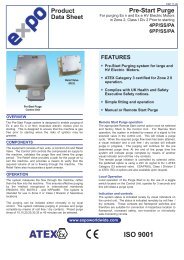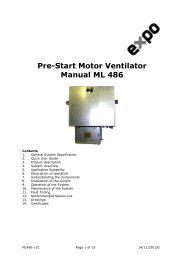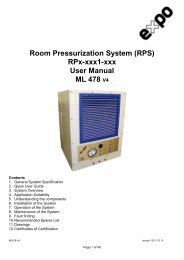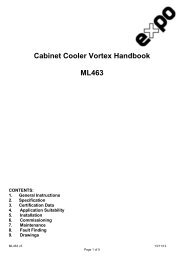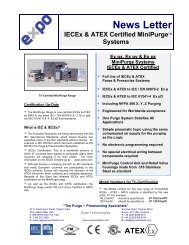Expo-Telektron Safety Systems Ltd - Expo Technologies
Expo-Telektron Safety Systems Ltd - Expo Technologies
Expo-Telektron Safety Systems Ltd - Expo Technologies
Create successful ePaper yourself
Turn your PDF publications into a flip-book with our unique Google optimized e-Paper software.
Installation, Operation and Maintenance Manual for MiniPurge �<br />
Leakage Compensation (Model LC) and<br />
MiniPurge � Continuous Flow with High Purge (Model CFHP)<br />
conforming to NFPA 496<br />
IMPORTANT NOTE It is essential, to ensure conformity with the standard,<br />
that the user of the system observes the following instructions.<br />
Please refer to the latest standard for detailed requirements and definitions.<br />
Contents:<br />
Section 0 Description and Principle of Operation<br />
Section 1 Installation of the System<br />
Section 2 Operation of the System<br />
All MiniPurge � pressurization systems provide:<br />
Section 3 Maintenance of the System<br />
Section 4 Fault Finding<br />
Section 5 Annex (if applicable)<br />
Section 0 Description and Principle of Operation<br />
a) a method of pressurizing a Pressurized Enclosure (PE)<br />
while at the same time compensating for any leakage,<br />
together with<br />
b) a method of purging the enclosure, before power is<br />
turned on, to remove any flammable gas that may have<br />
entered the enclosure while it was not pressurized.<br />
Type Leakage Compensation (LC) and Continuous<br />
Flow with High Purge (CFHP) systems comprise the<br />
following two major parts:<br />
- A Control Unit (CU) containing as a minimum, for “Y”<br />
and “Z” Pressurization, a Leakage Compensation Valve<br />
(LCV), Minimum Pressure and Purge Flow sensing<br />
devices, and a “Pressurized”/”Alarm” indicator. The CU<br />
supplies a ‘Pressurized’ signal showing whether the PE<br />
pressure is satisfactory or not.<br />
For Type “X” Pressurization, the CU has, in addition, a fully<br />
automatic Purging controller with a Purge timer and<br />
electrical power switch interlock.<br />
- A Relief Valve (RLV), fitted to the PE, to provide a<br />
means of limiting the maximum pressure experienced by<br />
the PE during operation. The RLV model number has<br />
suffixes defining the diameter of the valve aperture (in<br />
millimeters) and material, e.g. RLV **/cs (Carbon Steel) or<br />
/ss (Stainless Steel). All RLVs incorporate a Spark Arrestor<br />
to prevent sparks being ejected from the PE through the<br />
RLV aperture.<br />
CFHP systems with a Continuous Flow of air after purging<br />
have a calibrated Outlet Orifice which can be either within<br />
the Relief Valve (suffix **/cf) or a separate item type SA**<br />
or SAU**.<br />
0.1 “Leakage Compensation” <strong>Systems</strong>, Model LC<br />
A Leakage Compensation System, Model LC, is intended<br />
to have minimal flow after the initial purge time. The PE is<br />
built as leak tight as possible and the LC system merely<br />
tops up for any enclosure leakage. The system provides an<br />
initial high flow of purging air that leaves the PE through<br />
the Relief Valve. After the initial purging has been<br />
completed the Control Unit changes over to Leakage<br />
Compensation mode and the Relief Valve closes. The only<br />
flow thereafter is the flow through the “Leakage<br />
Compensation Valve” (LCV) which is adjusted so that the<br />
flow is enough to compensate for any leakage from the PE.<br />
The Purging Flow rate is monitored by a separate<br />
“Purge Flow Sensor” located in the CU, which detects<br />
the differential pressure across the purge flow orifice<br />
located directly before the RLV. The Purge Flow<br />
Sensor is set to operate when the desired differential<br />
pressure is exceeded. The output from the Flow<br />
Sensor is indicated on the CU and on “X”<br />
Pressurization systems, used to operate the automatic<br />
purge timer. Both Enclosure Pressure and Purge Flow<br />
have to be correct before the Purge Timer can start.<br />
0.2 “Continuous Flow after High Purge”, Model<br />
CFHP System<br />
The CFHP system construction is identical to a LC<br />
model, with the addition of one or more fixed Outlet<br />
Orifices to provide a deliberate “leak” at a known flow<br />
rate. The Outlet Orifice is pre-calibrated so that the<br />
pressure drop at the desired flow rate is known. The<br />
Minimum Pressure Sensor within the Control Unit will<br />
be set to the same value as the pressure drop. When<br />
the PE pressure exceeds the calibrated pressure the<br />
Continuous Flow must be taking place.<br />
The Leakage Compensation Valve in the CU is opened<br />
sufficiently to provide enough air to compensate for<br />
any accidental leakage as well as to provide the<br />
Continuous Flow through the outlet orifice. In this way<br />
a high flow rate is provided during the initial purge<br />
period which is thereafter reduced to the desired<br />
Continuous Flow rate. Even if the PE had no<br />
accidental leakage there would still be a flow from the<br />
outlet orifice.<br />
There are three ways of providing the calibrated Outlet<br />
Orifice. Please consult the system specification sheet<br />
to determine which has been supplied. The choice:<br />
- Type SAU** where an Orifice disk is removable and<br />
can be easily changed by the user to give different flow<br />
rates according to the size of the PE and the available<br />
air supply capacity. (** denotes the metric thread size<br />
of the SAU body)<br />
- Type SA** where the orifice size is fixed and the way<br />
to change the flow rate is either to change the setting<br />
of the Minimum Pressure Sensor or to replace the SA<br />
with one of another size. (** denotes the nominal<br />
thread size of the SA body)<br />
<strong>Expo</strong> <strong>Technologies</strong> Limited � Page 1 of 7 ML384 Issue 03 – 09.01.13


